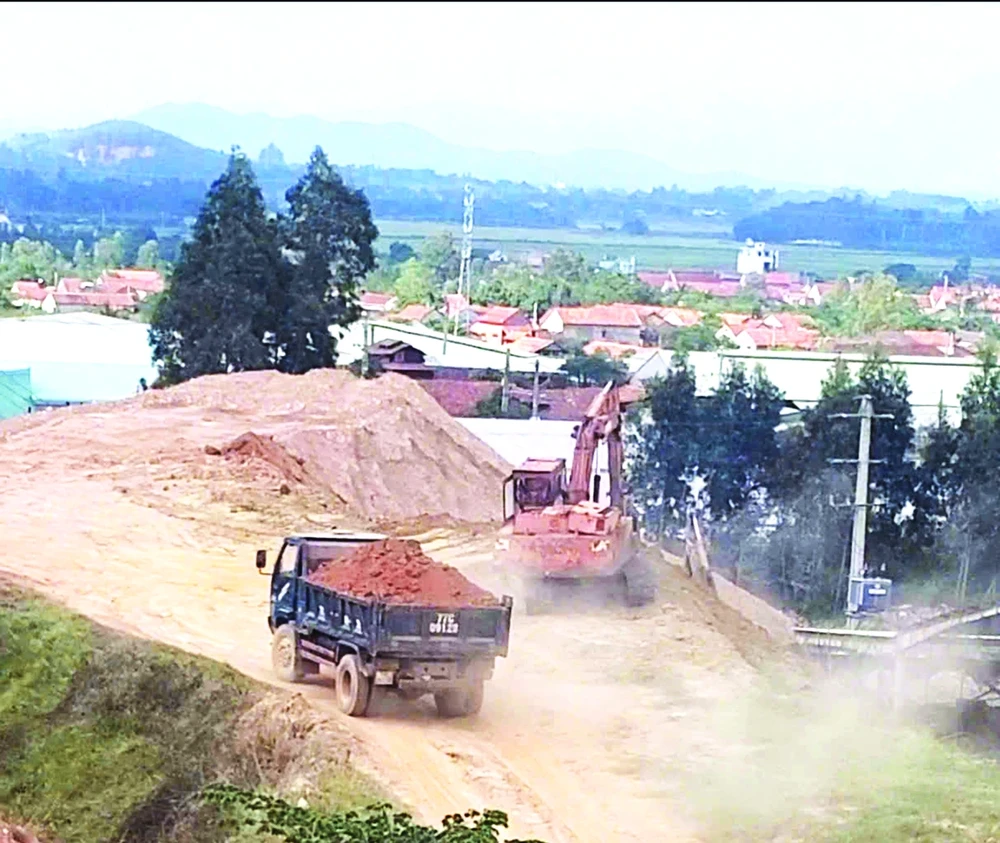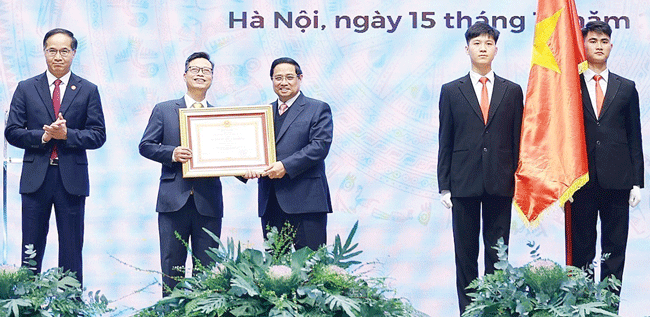
Binh Dinh Province’s clay deposits, often likened to "gray gold," have been subject to significant depletion and loss over the years. T., a local land expert in Tay Son District outlined several hotspots of illegal mining activity, recounting how businesses often acquire land in hilly areas, farmland, and orchards, subsequently deploying heavy machinery to extract clay and colored gravel.
A truckload of clay, weighing approximately 6 tonnes, can fetch up to VND3 million (US$120), while larger trucks carrying 10-12 tonnes can command double that price.

The two industrial clusters nearby, namely Phu An and Tay Xuan (both in Tay Xuan Commune of Tay Son District), lie at the food of Chop Vang Mountain. They have transformed into vast construction sites, littered with immense clay and sand deposits spread across dozens of hectares, belonging to the two clay and stone mines.
One of these mines, belonging to The Sang Trading Co., was officially permitted for mining construction materials in Phu An Village. However, during the months of July, August, and September 2024, the company utilized heavy machinery to excavate deep into the mountainside, extracting clay. Additionally, they subcontracted a brick kiln owner to extract colored gravel and clay from the mine.

Daytime operations were insufficient, prompting this company to extend mining activities into the night. The scale of these operations has been witnessed, with multiple excavators and trucks illuminated by powerful lights, digging deep into the mountainside and transporting clay to other places for trading.
On September 16, at the foot of Ba Mountain in Chi Thanh town (Tuy An District of Phu Yen Province), several vehicles and machinery were actively excavating the area. A significant portion of the hillside had been severely eroded.
Early in the morning of September 17, an excavator was relentlessly digging into the hillside, while numerous 6-8 ton trucks were continuously arriving to collect the extracted material. These trucks then sell the exploited material to construction sites in need in the locality, with a price of VND380,000 ($15) per load.

Local residents reported that illegal mining activities at Ba Mountain have persisted for years, resulting in potential losses amounting to billions of VND.
Chairman Huynh Kim Anh and Vice Chairman Nguyen Duc Minh of Chi Thanh Town's People's Committee acknowledged the illegal mining activities and the local authorities' efforts to apprehend the perpetrators through surveillance and enforcement actions. However, they admitted that the illicit operations continue to persist.
Hon Cha Mountain in Tran Quang Dieu Ward of Quy Nhon City has become a notorious symbol of relentless illegal mining activities. An investigation of the mountain's eastern slopes reveals a disheartened sight of extensive excavation and damage caused by businesses seeking to expand their operations.

From the mountain top, the severe degradation of Hon Cha Mountain was evident. The 220kV Quy Nhon-Tuy Hoa power line running along the mountainside appeared increasingly vulnerable to potential collapse.
The investigators encountered individuals guarding various paths leading to the mountain. These individuals, likely hired by mining operators, established makeshift shelters to monitor and deter unauthorized access. Beyond these checkpoints, the once-verdant mountainside was scarred by deep excavations and covered in a layer of white dust.
Vice Chairman Tran Son Binh of the Tran Quang Dieu Ward People's Committee expressed frustration over the situation, attributing it to past administrative decisions that allowed businesses to expand their operations deep into the mountainside. These businesses have since established barriers and engaged in extensive excavation, severely altering the mountain's landscape.
The ward has deployed forces to conduct nighttime surveillance and apprehend individuals involved in illegal mining, such as those associated with Xuan Nguyen Co. However, the company has challenged the authorities' actions through legal proceedings and continued to defy regulations. A complex network of individuals, potentially orchestrated by businesses, is involved in these illegal operations, with lookouts monitoring for law enforcement presence. When the functional agencies arrive, the miners quickly retreat into hidden tunnels.

The construction of expressways through the Central and Central Highlands regions requires hundreds of millions of cubic meters of earth and stone. To meet this demand, authorities have granted permits for numerous new mines.
For instance, ten component projects of the expressway from Ha Tinh Province to Khanh Hoa Province require 47.09 million cubic meters of earth fill, sourced from 21 existing mines and 71 newly approved mines. Similarly, the Khanh Hoa-Buon Ma Thuot Expressway project relies on over 20 authorized mines for earth and stone.
The investigation has also been able to identify several irregularities at various mines supplying materials for the North-South Expressway. At mines TDTS23 (Thom Mountain) and TDTS27 (Hon Troc Trong Mountain) in Tay Son District of Binh Dinh Province, extensive mining activities were observed in July, August, and September 2024, without the installation of electronic weighing stations or surveillance cameras, or with deliberate avoidance of such facilities. This might cause significant losses in terms of resources and tax revenue.
The Inspectorate of the Government has previously identified violations in the Cam Lo-La Son and Mai Son-National Highway 45 expressway projects, including inaccuracies in surveys, investigations, and assessments of mineral reserves and quality, resulting in significant environmental damage.
Moreover, the ineffectiveness of certain mines has necessitated the approval of additional mines, as exemplified by the Mai Son-National Highway 45 project, where 20 out of 37 approved mines failed to deliver adequate materials.
























